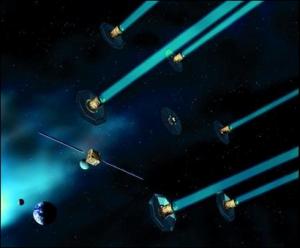The European Space Agency’s DARWIN mission is all about detecting Earth-like planets, as well as analyzing their atmospheres and determining their ability to sustain life. With the mission currently in its ‘definition’ phase, where parameters are determined and designs weighed, Lisa Kaltenegger (Harvard-Smithsonian Center for Astrophysics) has made her Ph.D work in astrophysics available to interested scientists. Written for Karl Franzens University in Graz, Kaltenegger’s study presents her work with the DARWIN team at the European Space Agency. Here you’ll find an evaluation of alternative designs and mission targets; the section on defining the features of a habitable world alone is worth the download of this enormous PDF file.
Scheduled for launch some time after 2014, DARWIN is a space-based interferometer designed to operate by pooling the data from free-flying craft working in tandem. At the heart of Kaltenegger’s work is a discussion of target star selection for DARWIN. As matters currently stand, some 826 stars (including multiple systems) are in the running, a list that will be narrowed with further modeling. Some salient points:
 Missions like DARWIN will add new depth to our understanding of exoplanetary systems. As Kaltenegger notes, the sensitivity of our current detection methods introduces an enormous bias in the direction of high mass companions close to the parent star; these are the most likely objects to be discovered by noting the apparent ‘wobble’ in a star’s motion as it is affected by such worlds.
Missions like DARWIN will add new depth to our understanding of exoplanetary systems. As Kaltenegger notes, the sensitivity of our current detection methods introduces an enormous bias in the direction of high mass companions close to the parent star; these are the most likely objects to be discovered by noting the apparent ‘wobble’ in a star’s motion as it is affected by such worlds.
Image: Darwin’s six telescopes look at light from space and analyse the atmospheres of Earth-like planets. Copyright: ESA 2002. Illustration by Medialab.
Can terrestrial planets form in such systems, or would those giant, close-in planets create instabilities fatal to their development? We won’t know the answers until DARWIN and Terrestrial Planet Finder provide us a big enough sample to draw some conclusions, and that makes the choice of target stars a critical matter.
“Search for Extra-Terrestrial planets: The DARWIN mission – Target Stars and Array Architectures” is available here, or via Kaltenegger’s page at the Center for Astrophysics site. Also see ESA’s home page for Darwin.

